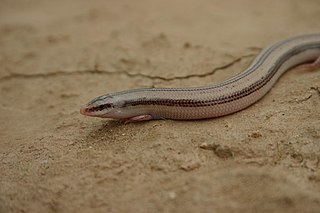
Skinks are lizards belonging to the family Scincidae, a family in the infraorder Scincomorpha. With more than 1,500 described species across 100 different taxonomic genera, the family Scincidae is one of the most diverse families of lizards. Skinks are characterized by their smaller legs in comparison to typical lizards and are found in different habitats except arctic and subarctic regions.

Ophiomorus is a genus of Old World skinks. The limbs are either reduced or absent, depending on the species. They are sometimes known as limbless skinks or snake skinks. Members of the genus live under rocks or in burrows.
Typhlacontias is a genus of legless, burrowing skinks in the family Scincidae, a genus endemic to Sub-Saharan Africa. Its sister group is the clade consisting of the genera Feylinia and Melanoseps.

Fernand Lataste was a French zoologist and herpetologist born in Cadillac, Gironde.

Ophiomorus raithmai, known commonly as the eastern sand swimmer and the three-fingered sand-fish, is a species of skink, a lizard in the family Scincidae. The species is found in India and Pakistan.
Ophiomorus tridactylus, commonly known as the three-toed snake skink, is a species of skink endemic to sandy desert areas of South Asia. It is also called the Indian sand-swimmer for its habit of moving just under the sand.

Latast's snake skink is a species of skink, a lizard in the family Scincidae. The species is endemic to the Near East.

The Greek snake skink is a species of skink, a lizard in the family Scincidae.

Scincinae is a subfamily of lizards. The subfamily contains 33 genera, and the genera contain a combined total of 284 species, commonly called skinks. The systematics is at times controversial. The group is probably paraphyletic. It is one of three subfamilies of the family Scincidae, the other two being Acontinae and Lygosominae.
Typhlacontias brevipes, also known as the FitzSimon's [sic] burrowing skink or short blind dart skink, is a skink species endemic to the Namib Desert (Namibia). It was described by Vivian FitzSimons in 1938.

Maranjab's snake skink is a species of skink, a lizard in the family Scincidae. It can be found in north-east of Kashan, Dasht-e Kavir, Iran. From snout to vent 95 mm, tail 81 mm.

The Persian snake skink is a species of skink endemic to Iran. A specimen collected in 1999 was found on sandy clay soil near Artemisia shrubs. It was originally described in 1867 as Hemipodion persicum.
The short-footed ctenotus is a species of skink found in Queensland in Australia.
Ophiomorus blanfordii, also known commonly as Blanford's snake skink, is a species of lizard in the family Scincidae. The species is native to Western Asia and South Asia.
Chernov's snake skink is a species of skink, a lizard in the family Scincidae. The species is native to Western Asia and Central Asia.
Ophiomorus kardesi is a species of skink, a lizard in the family Scincidae. The species is from Turkey.

Ophiomorus nuchalis, the Nilson's snake skink or plateau snake skink, is a species of skink, a lizard in the family Scincidae. The species is endemic to Iran.

Street's snake skink is a species of skink, a lizard in the family Scincidae. The species is from Iran.









